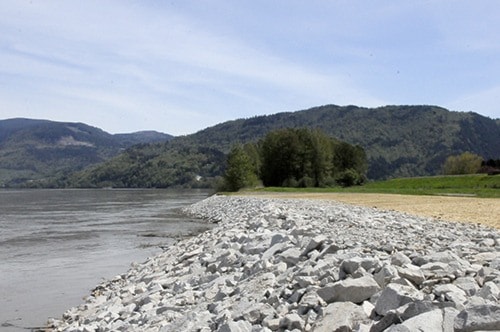More than $1 million has been invested by the City of Abbotsford into a “band-aid solution” for riverbank erosion on the Fraser River – and it may cost more in the future if the provincial and federal governments don’t come up with a long-term plan.
But the province says there is no plan on the horizon as potential solutions are too expensive.
Last summer, an arc of eroded land was noticed within 30 metres of the dike near Beharrell Road. The city raised the alarm that the erosion was potentially threatening the dikes, which if breached, could flood 12,000 acres of farmland, the railroad base, the Abbotsford-Mission Highway and bridge, as well as the sewer treatment plant.
The erosion is occurring in Matsqui Trail Regional Park – land owned by Metro Vancouver – and management of the Fraser River falls under provincial jurisdiction. Although the issue is outside the city’s responsibility, representatives say they have little choice but to pay to fix it.
Earlier this year, council ultimately decided to find the funds to complete the project before the spring freshet, due to concerns that higher water levels could compromise the dike. In 2008, the province gave the city $1.1 million to fix other erosion arcs, but those funds were reallocated to make up some of the $2.6 million needed to deal with the more pressing erosion that occurred last year.
The province has since stepped up with an additional $250,000, but the city is still left with a bill of about $1.25 million, and the original project has been left without funding.
Though Emergency Management BC can provide funds for flood protection, Abbotsford’s call was rejected because the threat to the dike was not deemed to be immediate.
Michael Church, a professor emeritus at the University of British Columbia and an expert on river geomorphology, erosion and sediment transport, said due to new regulations in 2004, unless a threat to the dike is truly imminent in the eyes of the province, repairs fall on the city.
Church explained that the erosion arcs around Abbotsford are a result of the river attempting to straighten its course at the Matsqui bend. The slope of the river flattens out near Abbotsford, causing gravel and sand to accumulate into sand bars. That forces the river to push hard against the bank, which scalps the soil and causes “small landslides,” resulting in erosion arcs.
One long-term solution would be to move the dike back and allow the river to “take the 40 or 50 metres that it might eventually want,” which would allow the water to move quicker and stop the growth of the sandbar,” Church said.
However, he acknowledges that this would likely not be a favourable option for the landowners who deem it to be valuable for farming.
A second effective option would be to pull back the gravel bar to minimize the pressure on the bank. But Church said the Department of Fisheries and Oceans often has concerns about how this could impact fish habitats.
The other issue is cost.
A letter sent to the city on Feb. 28 from Attorney-General Suzanne Anton and Minister of Forests, Lands and Natural Resource Operations Steve Thomson, in response to the city’s request for funding, said erosion is a common and natural process across B.C.
The letter states that erosion mitigation is complex and opinions on appropriate measures to deal with it “can be contradictory.” The province maintains that creating a comprehensive erosion control program is “fiscally prohibitive.”
The letter did say that the province is willing to work with jurisdictions on “a long-term plan to help identify areas of strategic importance and vulnerability due to exceptional erosion.”
In response to questions from The News, the ministry said exceptional erosion is considered to be unpredictable, threatening safety or public infrastructure.
The ministry added that at this point the province “does not have a program available to provide additional support (to Abbotsford).”
Church said that considering the erosion near Matsqui to not be a priority is “a somewhat short-sighted view to take,” noting that fixing the problem now would likely be cheaper than when it further threatens the dikes.
Mayor Bruce Banman said stakeholders are now looking at ways to c
onvey this significance to the provincial and federal government, and the minister of justice expressed interest in examining the erosion.
Abbotsford-Mission MLA Simon Gibson, who camp
aigned for the additional funding, said he will make addressing the issue of erosion a priority, but added that as the Liberal government is “running a balanced budget,” they are not always able to meet the expectations of local governments and residents.
The repairs on the most urgent erosion arc are complete, but there remains no long-term solution.
Church said although there are various options that could fix the problem – fixing the river channel, armouring banks, or letting the river carve a new course – the real problem will be choosing which one to follow.
“The essential issue is the socio-political one of making up one’s mind on which (plan) to follow. No one strategy is going to satisfy anyone.”

This Google Earth image shows three erosion arcs along the bank of the Fraser River in Abbotsford.
